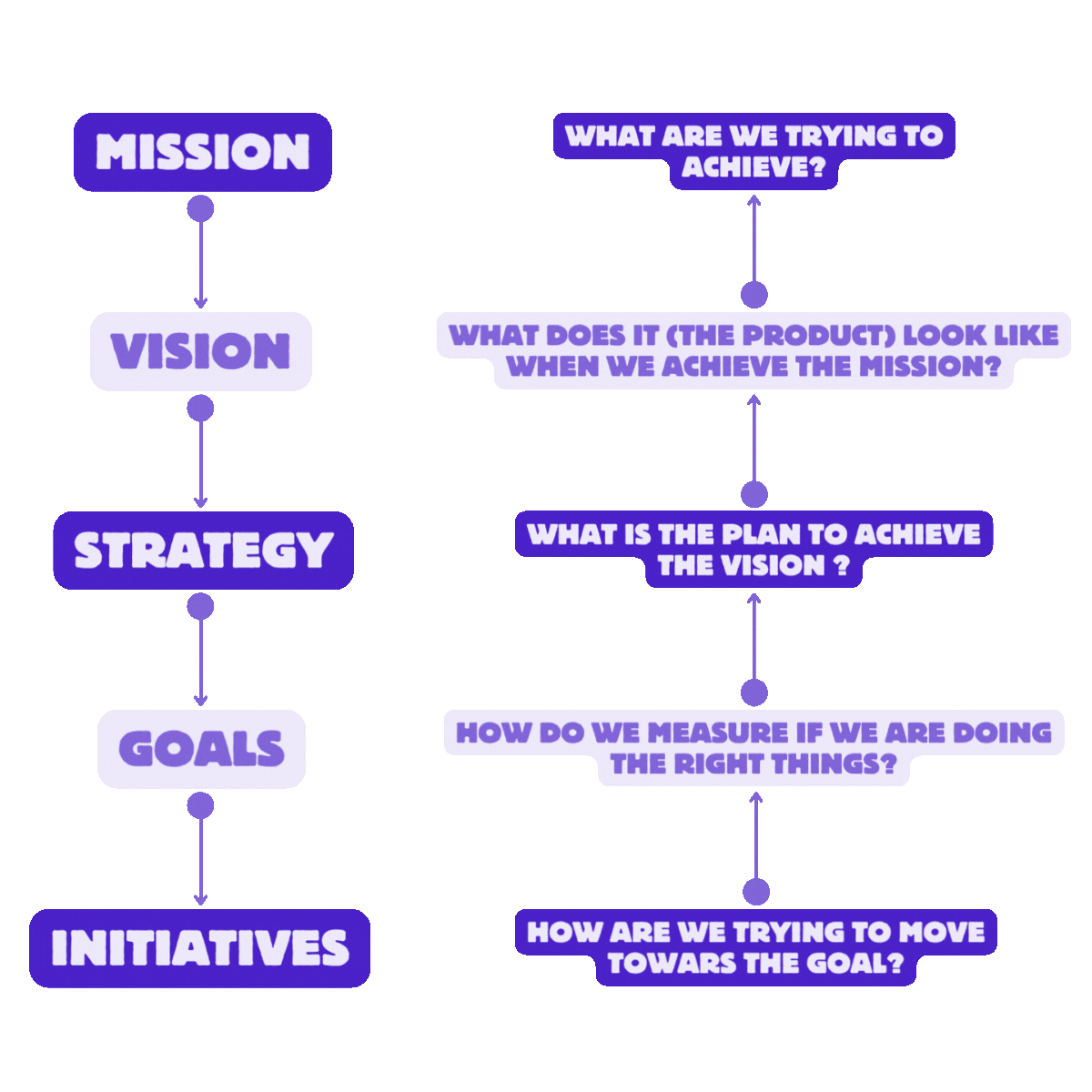Product strategy and vision are often what (product) leaders claim to spend the most time on, but what are they? What’s their purpose and what do they look like?
From Mission to Feature
In theory, there should be a connection between the company mission and the actual things the company is building. Yet this usually very abstract concept of the mission is rarely directly connected to the features built in the day-to-day. But what can and should be done is to understand why something is built. This is where the layers in between come into play: Mission → Vision → Strategy → Goal(s) → Initiatives
Mission: Your Identity
The mission is the foundation upon which all other strategic layers are built. It describes the purpose of your organization: Why it exists. A mission statement provides a clear focus and direction for the company and informs the broader objectives that the organization aims to achieve. It should resonate with internal stakeholders and your target audience.
For example: “To inspire and develop the builders of tomorrow.” - LEGO’s mission.
This Mission statement creates something that resonates with the people at LEGO and parents buying for their children.
Vision: What’s the Big Picture?
The vision is the future state you are striving to achieve. It's an inspirational description of what you want your product or service to become or accomplish in the long run. The vision should be ambitious and serve as a north star for all strategic decisions. In simple terms, the vision should describe what the product looks like once you have achieved your mission.
For example, if you are a transportation company, your vision could be to create the world's most efficient and safe transportation system.
Strategy: The Roadmap to Your Vision
Strategy is your game plan for achieving your vision. It outlines the approaches you take to overcome challenges and capitalize on opportunities. In essence, the strategy is your high-level method for moving from where you are now to where you want to be (the vision or closer to your vision).
For example, for a software company trying to win the insurance sector, their strategy could be integrating with existing banks to offer their products directly to the bank’s consumers.
Goals: Your Measurable Objectives
Goals are specific, measurable objectives that provide a way to assess whether your strategy is effective. For a particular period, (e.g.: one quarter, half a year), they are what your teams should be incentivized to work towards, so you to get your strategy executed. Each goal should align with a component of your strategy and collectively they should advance you toward your vision.
For a B2B SaaS company providing a product for creators to publish their posts, a goal could be to increase their free to paid conversion from 7% → 12% within 6 months.
Initiatives: Tactical Execution of Goals
Initiatives are the projects or actions taken to achieve your goals. These are your tactics, the actual steps you will take to move the needle. Initiatives require resources, scheduling, and prioritization, and they should be directly linked to at least one goal, ideally filling the gap between your current state and where a goal requires you to be.
Picking up the transportation example again, an initiative might be the launch of a referral program designed to increase the user base as part of a broader goal to expand market reach.
Connecting the Dots: From Mission to Features
Understanding how these layers interact and support one another is important for maintaining strategic alignment throughout your organization. Each feature developed should support an initiative, which in turn moves a goal, advances a strategy, and gets you closer to your vision, ultimately fulfilling your mission. This cascading effect ensures that every product decision and feature developed is not just a random innovation but a strategic step toward your ultimate objective.
For product leaders, you should craft these definitions and communicate them effectively throughout the organization. Ensuring that every team member understands not just what they are working on, but why. It turns daily tasks into contributions towards a larger purpose, which is essential for success.
In Conclusion
Creating and maintaining a clear connection from your mission to your product features through vision, strategy, goals, and initiatives does more than guide your product development. It aligns your entire organization, improves execution, and ensures that every effort is contributing towards a common mission.
Understanding and implementing this layered approach can transform abstract ambitions into concrete targets, making them actionable and achievable.
VERSUS Series
The VERSUS series is a set of 8 newsletter articles (2 per week) that answer questions PMs ask themselves all the time. Check out the other articles below!









